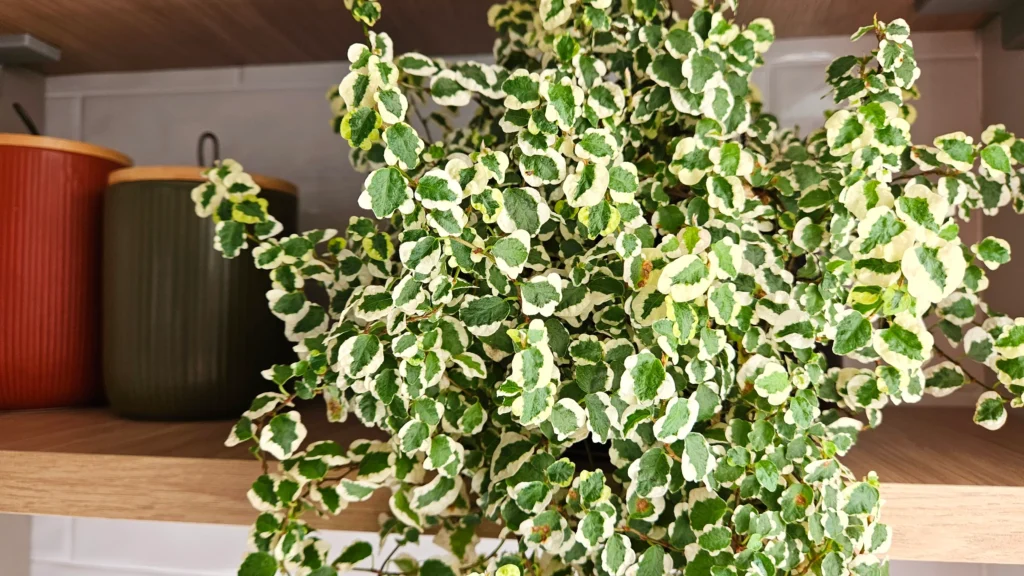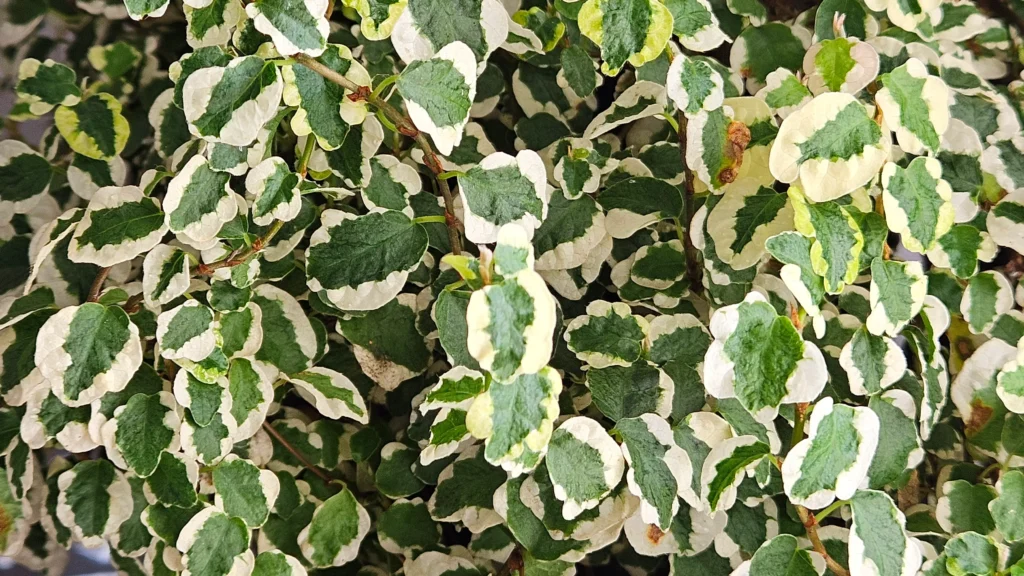
The Ficus Pumila Variegata, also known as variegated creeping fig, is a charming plant that captivates with the delicacy of its light green leaves with cream-colored edges. Ideal for covering walls, fences, or even as a hanging plant indoors, this species combines beauty, resilience, and versatility. In this complete guide, you will learn all the essential care tips, cultivation advice, interesting facts, and how to make the most of this natural gem.
What is Ficus Pumila Variegata?
Ficus Pumila Variegata is a variety of the Ficus pumila species, belonging to the Moraceae family, commonly known as variegated creeping fig. Native to Asia, specifically China, Japan, and Vietnam, this plant has gained prominence in landscaping projects around the world due to its versatility and visual appeal.
Its growth habit is climbing and creeping, using adventitious roots to attach itself to porous surfaces such as walls, fences, and tree trunks. In indoor environments, it is cultivated as a hanging plant, forming beautiful cascades of foliage.
The Variegata variation is appreciated for its small, heart-shaped leaves with light green coloration and cream or white edges, creating a delicate and ornamental contrast. This variation is less vigorous than the typical species, making it ideal for controlled spaces such as pots and vertical gardens.
Beyond its decorative value, Ficus Pumila Variegata is also recognized for its coverage capacity and resistance in different climate conditions, adapting well to tropical and subtropical regions.
Its growth is moderate to fast, depending on light conditions, humidity, and available space. In outdoor areas, it can reach up to 5 meters in extension, while in pots its development is more contained.
This plant is an excellent choice for those looking to add texture and lightness to landscaping without sacrificing practicality and low maintenance.
Main Characteristics
- Plant type: Perennial climber
- Size: Can reach up to 5 meters in outdoor environments
- Foliage: Small, variegated, light green with cream edges
- Growth: Moderate to fast, especially in humid environments
- Ideal environment: Outdoor (walls, fences) or indoor as a hanging plant
Ideal Lighting for Ficus Pumila Variegata
Lighting is a crucial factor for maintaining the variegated coloration of the leaves:
- Bright indirect light: Ideal for indoor environments. Near filtered windows or on balconies.
- Full sun with protection: In outdoor areas, it should receive filtered sun or gentle direct light (morning or late afternoon).
- Avoid strong midday sun: Can burn the delicate leaves, damaging the color variation.
Easy Flora Tip:
The more indirect light Ficus Pumila Variegata receives, the more intense the color variation in the leaves will be.
How to Care for Ficus Pumila Variegata

Caring for Ficus Pumila Variegata involves attention to essential factors to maintain its health and beauty, especially considering its climbing nature and variegated leaves sensitive to light and humidity.
Watering
- Keep the soil slightly moist, without waterlogging.
- In summer, frequent watering (2 to 3 times per week) is necessary to compensate for evaporation.
- In winter, water only when the substrate is dry on the surface.
- Use chlorine-free or filtered water to avoid stains on the sensitive leaves.
Soil
- Prefers well-drained, light, and fertile substrate.
- Recommended mix: garden soil + worm humus + coarse sand (2:1:1).
- Adding perlite or coconut fiber can improve aeration and moisture retention without waterlogging.
Humidity
- Ficus Pumila Variegata appreciates humid environments.
- In places with dry air (air conditioning or heating), misting the leaves with filtered water is essential.
- Grouping plants or using trays with water and pebbles helps maintain humidity.
Pruning
- Containment pruning controls growth and stimulates new shoots.
- Pruning is recommended at the beginning of spring for a more compact form.
- Removing dry leaves and branches prevents pests and diseases.
Fertilization
- Fertilize every 15 days in spring and summer with balanced liquid fertilizer (NPK 10-10-10).
- In autumn and winter, reduce to monthly.
- For cultivation in small pots, dilute the fertilizer to avoid salt buildup.
Extra: Support and Attachment
- In vertical areas, Ficus Pumila Variegata attaches itself with adventitious roots.
- It is advisable to guide the first branches and provide a porous surface (screens, trellises, or rough walls).
- For hanging cultivation, no support is needed.
Easy Flora Tip:
A weekly inspection of the leaves helps identify signs of stress (wilting, spots, pests) and correct problems before they worsen.
With these care tips, Ficus Pumila Variegata will develop exuberantly, maintaining its vibrant coloration and bringing charm to both indoor and outdoor environments.
Watering
- Keep the soil moist, but not waterlogged.
- In hot seasons, water 2 to 3 times a week.
- Reduce frequency in winter, watering only when the substrate dries on the surface.
Soil
- Well-drained and rich in organic matter.
- Ideal mix: garden soil + worm humus + coarse sand (2:1:1).
Humidity
- Appreciates high relative air humidity.
- Regular misting helps, especially in climate-controlled environments.
Pruning
- Can be pruned regularly to control growth and stimulate branching.
- Remove dry or damaged leaves.
Propagation of Ficus Pumila Variegata
Propagating Ficus Pumila Variegata is a simple and rewarding practice, ideal for those who want to multiply their plants at home. The most common method is by stem cuttings, but it’s also possible to use techniques such as adventitious shoots and layering.
Stem Cuttings
- Choose healthy branches, about 10 to 15 cm long.
- Remove the lower leaves, leaving only 2 to 3 leaves at the top.
- Plant the cuttings in moist, well-drained substrate.
- Keep in a shaded location with high humidity until rooting, which occurs between 3 to 6 weeks.
Adventitious Shoots
- In mature plants, small shoots often appear at the base of the stem.
- These shoots can be carefully separated and replanted in their own pots.
- It’s a quick and efficient way to multiply the plant.
Layering
- An interesting method for vertical coverage.
- It involves partially burying a branch still attached to the mother plant, stimulating rooting at that point.
- After rooting, cut the connection and transplant the new plant.
Extra Tips
- Use rooting hormone to accelerate the process and increase the success rate.
- Cover the container with clear plastic (greenhouse-type) to maintain humidity.
- Avoid direct sun exposure during rooting, prioritizing locations with diffused light.
Propagating Ficus Pumila Variegata is not only an excellent way to expand your collection but also allows you to create beautiful decorative compositions with multiple plants in pots or vertical gardens.
- Stem cuttings: The simplest form of propagation.
- Cut branches 10-15 cm long, remove lower leaves, and plant in moist substrate.
- Keep in a shaded location until rooting.
Common Problems and How to Solve Them
Yellowing Leaves
- Excess water or poor drainage.
- Solution: Adjust watering and improve the substrate.
Dry Leaf Tips
- Low air humidity or excessive sunlight.
- Solution: Increase humidity and protect from direct sun.
Pests
- Scale insects and aphids may attack.
- Solution: Manual cleaning with a damp cloth and application of insecticidal soap.
Interesting Facts about Ficus Pumila Variegata
- In nature, Ficus Pumila is used to cover temple facades and walls in Asian gardens.
- Its aerial roots adhere easily to rough surfaces.
- Although it’s a small plant in pots, it can become invasive in gardens if not controlled.
Ficus Pumila
Where to Buy Ficus Pumila Variegata
- Garden centers and flower shops.
- Reliable e-commerce sites with good delivery policies.
Be Careful About the Source
Avoid buying plants from uncertified sellers. Prefer local producers or recognized online stores, ensuring plant health and sustainable practices.
FAQ – Frequently Asked Questions
Is Ficus Pumila Variegata toxic?
Yes, like other ficus species, the sap can cause irritation to sensitive skin and is toxic if ingested by pets.
Can it be grown in apartments?
Yes! As long as it receives abundant indirect light and has space to grow as a hanging plant or on vertical supports.
How to make Ficus Pumila Variegata grow fuller?
Regular pruning of the tips stimulates lateral branching, making the plant denser and more voluminous.
Does it need support to grow?
Yes, to grow vertically, it needs support or a surface to attach to. In hanging pots, it naturally grows downward.
Can it be grown in full shade?
It is not recommended. Full shade causes the plant to lose its color variation, becoming uniformly green and more susceptible to pests.
